Thermal Maturity and Kerogen Type of Badenian Dispersed Organic Matter from the Getic Depression, Romania
Abstract
:1. Introduction
2. Geological Setting
- the Globigerina-bearing tuffs and marls (Lower Badenian).
- the salt breccia (Upper Badenian), with gypsum interlayers.
- the radiolaria-bearing shales.
- the Spiratella-bearing marls (ending the Badenian).
3. Materials and Methods
4. Results and Discussions
4.1. Petrology of the Dispersed Organic Matter
4.2. Geochemical Assessment
4.3. Statistical Analysis
5. Conclusions
Author Contributions
Funding
Data Availability Statement
Acknowledgments
Conflicts of Interest
References
- Ghiran, M.D.; Popa, M.E.; Mariș, I.; Gheorghe, S. Petrography and geochemistry of dispersed organic matter in the Oligocene source rocks of the central-western part of the Getic Depression, Romania. Int. J. Coal Geol. 2018, 200, 153–165. [Google Scholar] [CrossRef]
- Paraschiv, D. Geology of hydrocarbon fields in Romania, Institute of Geology and Geophysics. Tech. Econ. Stud. Ser. A 1975, 10, 375. (In Romanian) [Google Scholar]
- Paraschiv, D. Romanian Oil and Gas Fields; Institute of Geology and Geophysics: Bucharest, Romania, 1979; Volume 383. (In Romanian) [Google Scholar]
- Motaş, C.; Nicolae, E.; Tudoran, C.; Horia, G.; Carp, V.; Giuglan, F.; Mihai, S.; Mihalache, M. Reconstruction of the Geological Evolution of the Getic Depression for the Qualitative Evaluation of the Oil Potential and the Specification of the Optimal Hydrocarbon Storage Areas; Geological Report: Petrom, SA, USA, 1995. [Google Scholar]
- Popescu, B.M. Romania’s petroleum systems and their remaining potential. Pet. Geosci. 1995, 1, 337–350. [Google Scholar] [CrossRef]
- Buliga, G.; Balteş, N. Petroleum systems in the Getic fields: Folded internal foreland structures. Oil Gas Monit. 2006, 5, 51. (In Romanian) [Google Scholar]
- Buliga, G.; Balteş, N. Petroleum Systems in the Getic Depression. Oil Gas Monit. 2006, 5, 22–24. (In Romanian) [Google Scholar]
- Ştefănescu, M.; Dicea, O.; Butac, A.; Ciulavu, D. Hydrocarbon Geology of the Romanian Carpathians, their Foreland, and the Transylvanian Basin. AAPG 2006, 84, 521–567. [Google Scholar]
- Krézsek, C.; Oterdoom, H.; Dzido, P.; Barbu, V.; Bland, S.; Amberger, K.; Lepădat, A. New Insights into The Hydrocarbon System of The Getic Depression, Romania: Implications for Exploration. In 73rd EAGE Conference & Exhibition Incorporating SPE EUROPEC; Didactical and Pedagogical Publishing House: Bucharest, Romania, 2011. [Google Scholar]
- Pawlewicz, M. Total Petroleum Systems of the Carpathian—Balkanian Basin Province of Romania and Bulgaria. USGS 2007, 2204, 17. [Google Scholar]
- Băncilă, I. Geology of the Eastern Carpathians; Editura Tehnică: Bucharest, Romania, 1958; p. 368. (In Romanian) [Google Scholar]
- Gavăt, I. Petroleum Geology and Natural Gas; Didactical and Pedagogical Publishing House: Bucharest, Romania, 1964; p. 303. (In Romanian) [Google Scholar]
- Mocuța, S.T.; Past, Present, and Future of the Research-Development (R&D). Activity related to the Upstream Segment of Romania’s Petroleum Industry. Rev. Română De Pet. Ser. Nouă 2009, 16, 5–12. [Google Scholar]
- Mocuța, S.T. Petroleum Basins and Fields on Earth; Publishing House of the Romanian Academy: Bucharest, Romania, 2017; p. 81. (In Romanian) [Google Scholar]
- Balteș, N. Metamorphism of different types of organic matter from sedimentary rocks of Romania and their importance for oil generation. In Proceedings of the 10th World Petroleum Congress, Bucharest, Romania, 9–14 September 1979; 43–47. [Google Scholar]
- Balteș, N. Complex Research Laboratory for the Knowledge of the Formation of Hydrocarbon Fields in the Northern Flank of the Getic Depression—Technical Report; Arhiva OMV—Petrom SA: Bucharest, Romania, 1980. (In Romanian) [Google Scholar]
- Balteș, N. Hydrocarbon source rocks in Romania. Annu. De L’institut De Geol. Et De Geophys. 1983, 60, 265–270. [Google Scholar]
- Motaş, C. New Data on Structural Relationships between the Southern Carpathians and the Getic Depression Lucr. Congr. XXI Assoc. Carp-Balc; Institute of Geology and Geophysics: Bucharest, Romania, 1983; Volume 141–146. (In Romanian) [Google Scholar]
- Buliga, G. Geological research for hydrocarbons in Greater Romania. NOEMA 2012, 11, 347–355. (In Romanian) [Google Scholar]
- Krézsek, C. Petroleum Systems of Romania. AAPG Eur. Reg. 2011, 10349, 4–7. [Google Scholar]
- Burgess, J.D. Microscopic Examination of Kerogen (Dispersed Organic Matter) in Petroleum Exploration. Geol. Soc. Am. Spec. Pap. 1974, 153, 19. [Google Scholar]
- Espitalié, J.; Laporte, J.L.; Madec, M.; Marquis, F.; Leplat, P.; Paulet, J.; Boutefeu, A. Methode rapide de caracterisation des roches meres, de leur potential petrolier et de leur degree d’evolution. Rev. Inst. Français Pet. Paris 1997, 32, 23–42. [Google Scholar]
- Durand, B. (Ed.) Kerogen Insoluble Organic Matter from Sedimentary Rocks; Institut Français du Pétrole: Paris, France, 1980; p. 474. [Google Scholar]
- Behar, F.; Beaumont, V.; Penteado, H.L. de B. Rock-Eval technology: Performances and developments. Oil Gas Sci. Technol. 2001, 56, 111–134. [Google Scholar] [CrossRef]
- Peters, K.E. Guidelines for evaluating petroleum source rock using programmed pyrolysis. Am. Assoc. Pet. Geol. Bull. 1986, 70, 318–329. [Google Scholar]
- Espitalié, J.; Deroo, G.; Marquis, F. Rock Eval pyrolysis and its applications. Inst. Français Du Pet. Paris 1985, 27299, 79008. [Google Scholar]
- Peters, K.E.; Cassa, M.R. Applied source rock geochemistry. In The Petroleum System—From Source to Trap; Magoon, L., Dow, W., Eds.; AAPG Memoir: Tulsa, OK, USA, 1994; pp. 93–120. [Google Scholar]
- Bordenave, M.L. (Ed.) Applied Petroleum Geochemistry; Editions Technip: Paris, France, 1993; pp. 210–366. [Google Scholar]
- Bordenave, M.L.; Espitalié, J.; Leplat, P.; Oudin, J.L.; Vandenbrouke, M. Screening techniques for source rock evaluation. Appl. Petrol. 1993, 1993, 217–278. [Google Scholar]
- Hunt, J.M. Petroleum Geochemistry and Geology; Freeman and Company: San Francisco, CA, USA, 1995; p. 743. [Google Scholar]
- Senftle, J.T.; Landis, C.R.; McLaughlin, R.L. Organic Petrographic Approach to Kerogen Characterization. In Organic Geochemistry; Springer: Boston, MA, USA, 1993; Volume 2239, pp. 355–374. [Google Scholar]
- Hartkopf-Fröder, C.; Königshof, P.; Littke, R.; Schwarzbauer, J. Optical thermal maturity parameters and organic geochemical alteration at low grade diagenesis to anchimetamorphism: A review. Int. J. Coal Geol. 2015, 150, 74–119. [Google Scholar] [CrossRef]
- Spina, A.; Vecoli, M.; Riboulleau, A.; Clayton, G.; Cirilli, S.; Di Michele, A.; Marcogiuseppe, A.; Rettori, R.; Sassi, P.; Servais, T.; et al. Application of Palynomorph Darkness Index (PDI) to assess the thermal maturity of palynomorphs: A case study from North Africa. Int. J. Coal Geol. 2018, 188, 64–78. [Google Scholar] [CrossRef]
- Galasso, F.; Fernandes, P.; Montesi, G.; Marques, J.; Spina, A.; Pereira, Z. Thermal history and basin evolution of the Moatize—Minjova Coal Basin (N’Condédzi sub-basin, Mozambique) constrained by organic maturation levels. J. Afr. Earth Sci. 2019, 153, 219–238. [Google Scholar] [CrossRef]
- Sorci, A.; Cirilli, S.; Clayton, G.; Corrado, S.; Hints, O.; Goodhue, R.; Schito, A.; Spina, A. Palynomorph optical analyses for thermal maturity assessment of Upper Ordovician (Katian-Hirnantian) rocks from Southern Estonia. Mar. Pet. Geol. 2020, 120, 104574. [Google Scholar] [CrossRef]
- Spina, A.; Cirilli, S.; Sorci, A.; Schito, A.; Clayton, G.; Corrado, S.; Fernandes, P.; Galasso, F.; Montesi, G.; Pereira, Z.; et al. Assessing thermal maturity through a multi-proxy approach: A case study from the Permian Faraghan Formation (Zagros Basin, Southwest Iran). Geosciences 2021, 11, 484. [Google Scholar] [CrossRef]
- Durand, B.; Alpern, B.; Pittion, J.L.; Pradier, B. Reflectance of vitrinite as a control of thermal history of sediments. In Thermal Modelling in Sedimentary Basins; Technip: Paris, France, 1986; pp. 441–474. [Google Scholar]
- Tissot, B.P.; Welte, D.H. Petroleum Formation and Occurrence; Springer: Berlin, Germany, 1984; Volume 699. [Google Scholar]
- Tissot, B.P.; Pellet, R.; Ungerer, P.H. Thermal history of sedimentary basins, maturation indices and kinetics of oil and gas generation. AAPG Bull. 1987, 71, 1445–1466. [Google Scholar]
- Waples, D.W. Geochemistry in Petroleum Exploration; Resources and Develop. Co.: Boston, MA, USA, 1985; Volume 232. [Google Scholar]
- Van Krevelen, D.W. Coal, Typology, Chemistry, Physics, Constitution; Elsevier: Amsterdam, The Netherlands, 1961; Volume 514. [Google Scholar]
- Schito, A.; Corrado, S.; Trolese, M.; Aldega, L.; Caricchi, C.; Cirilli, S.; Grigo, D.; Guedes, A.; Romano, C.; Spina, A.; et al. Assessment of thermal evolution of Paleozoic successions of the Holy Cross Mountains (Poland). Mar. Pet. Geol. 2017, 80, 112–132. [Google Scholar] [CrossRef]
- Schito, A.; Spina, A.; Corrado, S.; Cirilli, S.; Romano, C. Comparing optical and Raman spectroscopic investigations of phytoclasts and sporomorphs for thermal maturity assessment: The case study of Hettangian continental facies in the Holy cross Mts. (central Poland). Mar. Pet. Geol. 2019, 104, 331–345. [Google Scholar] [CrossRef]
- Schito, A.; Atouabat, A.; Muirhead, D.K.; Calcagni, R.; Galimberti, R.; Romano, C.; Spina, A.; Corrado, S. An insight on the polyphase thermal history of the Internal Rif (Northern Morocco) through Raman micro-spectroscopy investigation. Ital. J. Geosci. 2022, 141, 104–119. [Google Scholar] [CrossRef]
- Spina, A.; Brogi, A.; Capezzuoli, E.; Ventruti, G.; Zucchi, M.; Aldinucci, M.; Liotta, D. Use of palynology and thermal maturity in deformed geological units: A case study from the Permian succession in the Monte Leoni area (Middle Tuscan Ridge, inner Northern Apennines, Italy). Sediment. Geol. 2022, 438, 106210. [Google Scholar] [CrossRef]
- Teichmüller, M. Organic petrology of source rocks, history and state of the art. Org. Geochem. 1986, 10, 581–599. [Google Scholar] [CrossRef]
- Teichmüller, M.; Durand, B. Fluorescence microscopical rank studies on liptinites and vitrinites in peat and coals, and comparison with results of the Rock-Eval pyrolysis. Int. J. Coal Geol. 1983, 2, 197–230. [Google Scholar] [CrossRef]
- Taylor, G.H.; Teichmüller, M.; Davis, A.; Diessel, C.F.K.; Littke, R.; Robert, P. Organic Petrology; Gebrüder Borntraeger: Stuttgart, Germany, 1998. [Google Scholar]
- Staplin, F.L. (Ed.) Determination of thermal alteration index from color of exinite (pollen, spores). In How to Assess Maturation and Paleotemperatures; SEPM Short Course: Tulsa, OK, USA, 1982; pp. 7–11. [Google Scholar]
- Stasiuk, L.D.; Fowler, M.G. Organic facies in Devonian and Mississippian strata of Western Canada sedimentary basin: Relation to kerogen type, paleoenvironment, and paleogeography. Bull. Can. Petrol. Geol. 2004, 52, 234–255. [Google Scholar] [CrossRef]
- Kus, J.; Araujo, C.V.; Borrego, A.G.; Flores, D.; Hackley, P.C.; Hamor-Vido, M.; Kalaitzidis, S.; Kommeren, C.J.; Kwiecinska, B.; Mastalerz, M.; et al. Identification of alginite and bituminite in rocks other than coal. 2006, 2009, and 2011 round robin exercises of the ICCP Identification of Dispersed Organic Matter Working Group. Int. J. Coal Geol. 2017, 178, 26–38. [Google Scholar] [CrossRef]
- Hackley, P.; Cardott, B.J. Application of organic petrography in North American shale petroleum systems: A review. Int. J. Coal. Geol. 2016, 163, 8–51. [Google Scholar] [CrossRef] [Green Version]
- Panaitescu, C.; Penu, A. Microscopic characterization of organic and mineral matter in rock and kerogen samples. IPB—Petromar 1988, 55, 84–118. (In Romanian) [Google Scholar]
- Panaitescu, C. Petrography of Coal, Coke and Carbonaceous Products. Encycl. Publ. House 1991, 323, 15146. (In Romanian) [Google Scholar]
- Cardott, B.J.; Lambert, M.W. Thermal maturation by vitrinite reflectance of the Woodford shale, Anadarko Basin, Oklahoma. AAPG Bull. 1985, 69, 1982–1988. [Google Scholar]
- Ghiran, M.D.; Popa, M.E.; Gheorghe, S. Characterization and evaluation of Badenian source rocks from the Central- Southern part of the Getic Depression, Romania. In Proceedings of the 71st Annual Meeting of the International Committee for Coal and Organic Petrology (ICCP), Symposium on Organic Petrology with special focus Oil Generation from Coals and Carbonaceous Shales, Hague, The Netherlands, 16–20 September 2019. [Google Scholar]
- Ghiran, M.D.; Popa, M.E.; Gheorghe, Ș. Identification of Macerals from Badenian Source Rocks of Centre Part of the Getic Depression; Geodoct Symposium: Bucharest, Romania, 2020. [Google Scholar]
- Săndulescu, M. Geotectonics of Romania; Technical Publishing House: Bucharest, Romania, 1984; p. 335. (In Romanian) [Google Scholar]
- Mutihac, V. The Geological Structure of Romania; Technical Publishing House: Bucharest, Romania, 1990; p. 419. (In Romanian) [Google Scholar]
- Mutihac, V.; Stratulat, M.I.; Fechet, R.M. Geology of Romania; Didactic and Pedagogical Publishing House: Bucharest, Romania, 2004; p. 249. (In Romanian) [Google Scholar]
- Mațenco, L.; Bertotti, G.; Dinu, C.; Cloetingh, S. Tertiary tectonic evolution of the external South Carpathians and the adjiacent Moesian platform (Romania). Tectonics 1997, 16, 896–911. [Google Scholar] [CrossRef] [Green Version]
- Răbăgia, T.; Füllop, A. Syntectonic sedimentation history in the Southern Carpathians foredeep, Berza, T., ALCAPA II: Geological evolution of the Alps-Carpathian-Pannonian System, Abstracts volume. Rom. J. Tecton. Regn. Geol. 1994, 75, 48. [Google Scholar]
- Mațenco, L.; Schmid, S.M. Exhumation of the Danubian nappe system (South Carpathians) during the Early Tertiary: Inferences from kinematic and paleostress analysis at the Getic/Danubian nappe contact. Tectonophysics 1999, 314, 401–422. [Google Scholar] [CrossRef]
- Mațenco, L.; Bertotti, G. Tertiary tectonic evolution of the external East Carpathians (Romania). Tectonophysics 2000, 316, 255–286. [Google Scholar] [CrossRef]
- Mațenco, L.; Krézsek, C.; Merten, S.; Schmid, S.M.; Cloetingh, S.; Andriessen, P. Characters of collisional orogens with low topographic build-up: An example from the Carpathians. Terra Nova 2010, 22, 155–165. [Google Scholar] [CrossRef]
- Schmid, S.M.; Bernoulli, D.; Fugenschuh, B.; Mațenco, L.; Schefer, S.; Schster, R.; Tischler, M.; Ustaszewski, K. The Alpin-Carpathian-Dinaridic orogenic system Correlation and evolution of tectonic units. Swiss J. Geosci. 2008, 101, 139–183. [Google Scholar] [CrossRef] [Green Version]
- Răbăgia, T.; Maţenco, L. Tertiary tectonic and sedimentological evolution of the South Carpathians foredeep: Tectonic versus eustatic control. Mar. Pet. Geol. 1999, 16, 719–740. [Google Scholar] [CrossRef]
- Kräutner, H.C.; Krstić, B. Alpine and Pre-Alpine structural units within the Southern Carpathians and the Eastern Balkanides. Proc. XVII. Congr. Carpathian-Balk. Geol. Assoc. Bratisl. Geol. Carpathica Spec. Issue 2002, 53, 7. [Google Scholar]
- Bădescu, D. The Tectono-Stratigraphic Evolution of the Eastern Carpathians during the Mesozoic and Neozoic; Economic Publishing House: Bucharest, Romania, 2005; Volume 312. (In Romanian) [Google Scholar]
- Tărăpoancă, M.; Ţambrea, D.; Avram, V.; Popescu, B. The geometry of the south leading Carpathian thrust line and the Moesia boundary: The role of inherited structures in establishing a transcurrent contact on the concave side of the Carpathians. In Thrust Belts and Foreland Basins: From Fold Kinematics to Hydrocarbon Systems: Frontiers in Earth Sciences; Lacombe, O., Lave, J., Roure, F., Verges, J., Eds.; Springer: Berlin/Heidelberg, Germany, 2007; pp. 492–508. [Google Scholar]
- Krézsek, C.; Lăpădat, A.; Mațenco, L.; Arnberger, K.; Barbu, V.; Olaru, R. Strain partitioning at orogenic contacts during rotation, strike-slip and oblique convergence: Palaeogene-Early Miocene evolution of the contact between the South Carpathians and Moesia. Glob. Planet. Chang. 2013, 103, 63–81. [Google Scholar] [CrossRef]
- Răbăgia, T.; Roban, R.D.; Tărăpoancă, M. Sedimentary records of Palaeogene (Eocene to Lowermost Miocene) deformations near the contact between the Carpathian Thrust Belt and Moesia. Oil and Gas Sci. Technol. 2011, 66, 931–952. [Google Scholar] [CrossRef]
- SR ISO 5069-2: 1994; Brown Coals and Lignites. Principles of Sampling. Part 2: Sampling for Determination of Moisture Content and for General Analysis. Romanian Standard Association: Bucharest, Romania, 1994; Volume 14.
- ISO 7404-2:2009; Methods for the Petrographic Analysis of Coals-Part 2: Methods of Preparing Coal Samples. International Organization for Standardization: Geneva, Switzerland, 2009; p. 12.
- ASTM D7708-11; Standard Test Method for Microscopical Determination of the Reflectance of Vitrinite Dispersed in Sedimentary Rocks. Annual Book of ASTM Standards: Petroleum Products, Lubricants, and Fossil Fuels; Gaseous Fuels; Coal and Coke. ASTM International: West Conshohocken, PA, USA, 2014.
- Lafarque, E.; Marquis, F.; Pilot, D. Rock-Eval 6 applications in hydrocarbon exploration; production, and soil contamination studies. Rev. De L’institut Français Du Pet. 1998, 53, 421–437. [Google Scholar] [CrossRef] [Green Version]
- ICCP. The new vitrinite classification (ICCP System 1994). Fuel 1998, 77, 349–358. [Google Scholar] [CrossRef]
- Pickel, W.; Kus, J.; Flores, D.; Kalaitzidis, S.; Christanis, K.; Cardott, B.J.; Misz-Kennan, M.; Rodrigues, S.; Hentschel, A.; Hamor-Vido, M.; et al. Classification of liptinite-ICCP System 1994. Int. J. Coal Geol. 2017, 169, 40–61. [Google Scholar] [CrossRef] [Green Version]
- Sýkorová, I.; Pickel, W.; Christanis, K.; Wolf, M.; Taylor, G.H.; Flores, D. Classification of huminite- ICCP System 1994. Int. J. Coal Geol. 2005, 62, 85–106. [Google Scholar] [CrossRef]
- ICCP. The new inertinite classification (ICCP System 1994). Fuel 2001, 80, 459–471. [Google Scholar] [CrossRef]
- Panaitescu, C.; Predeanu, G. Carbopetrographic Atlas; Publishing House of the Romanian Academy: Bucharest, Romania, 1999; Volume 264. (In Romanian) [Google Scholar]
- Falcon, R.M.S.; Snyman, C.P. An introduction to coal petrography: Atlas of petrographic constituents in the bituminous coals of Southern Africa. Geol. Soc. South Afr. 1986, 2, 106. [Google Scholar]
- Wagner, N.; Malumbazo, N.; Falcon, R. Southern African Coals and Carbons; Struik Nature: Cape Town, South Africa, 2018; p. 248. [Google Scholar]
- Carr, A.D. Suppression and retardation of vitrinite reflectance, part 1. Formation and significance for hydrocarbon generation. J. Pet. Geol. 2000, 23, 313–343. [Google Scholar] [CrossRef]
- Snowdon, L.R.; Fowler, M.G. Interpretation of organic geochemical data. In Canadian Society of Petroleum Geologists; Short Course Notes: Nutley, NJ, USA, 1997; Volume 86. [Google Scholar]

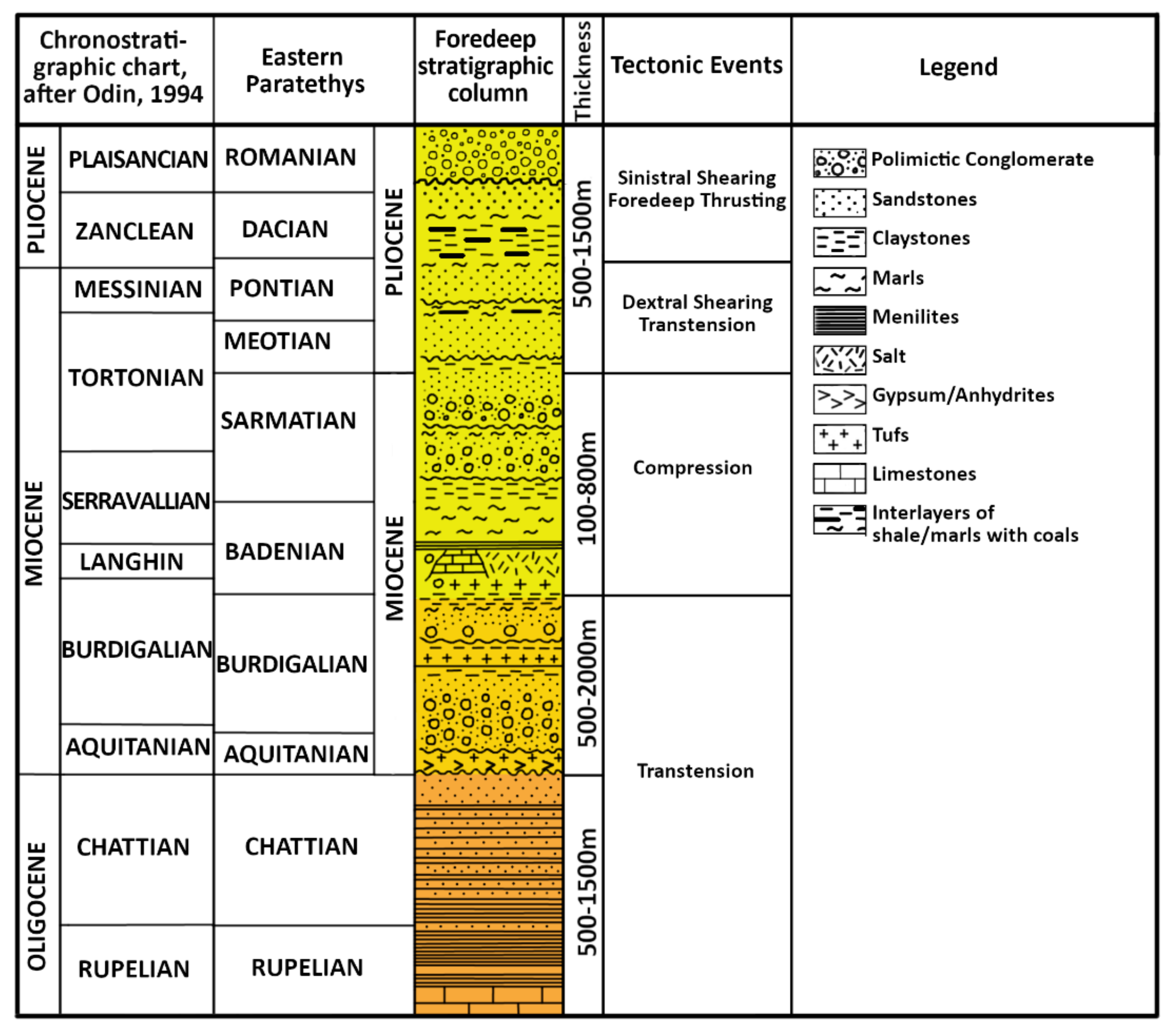
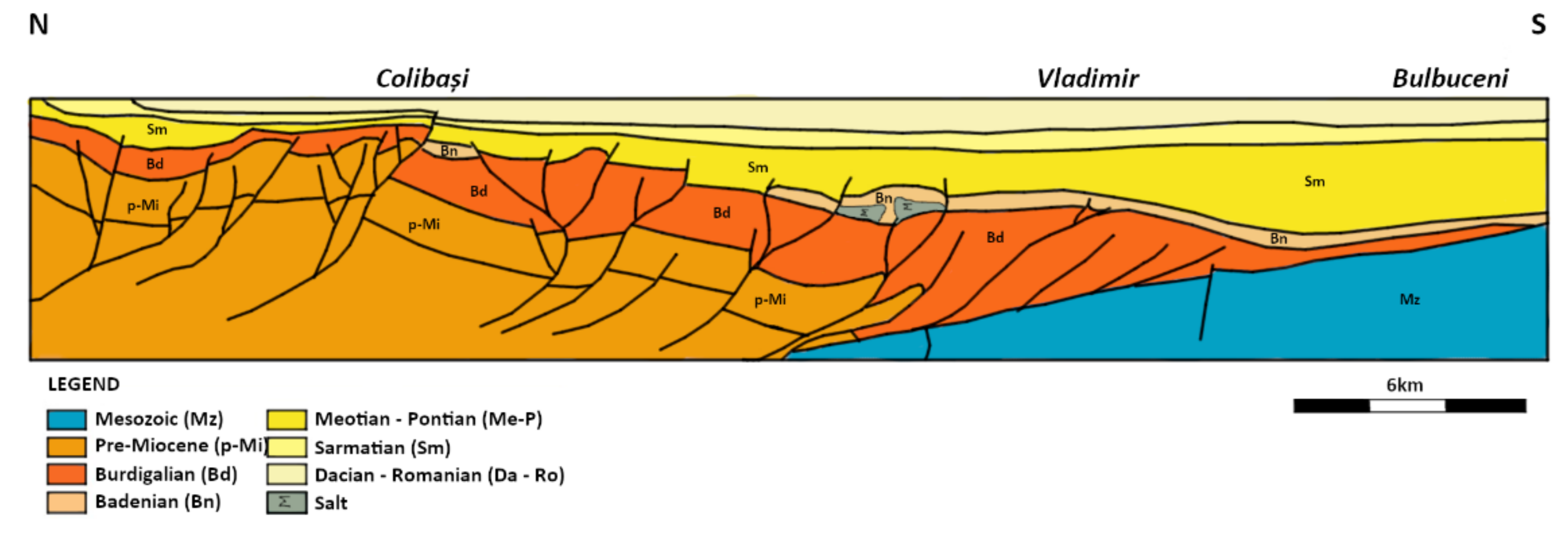
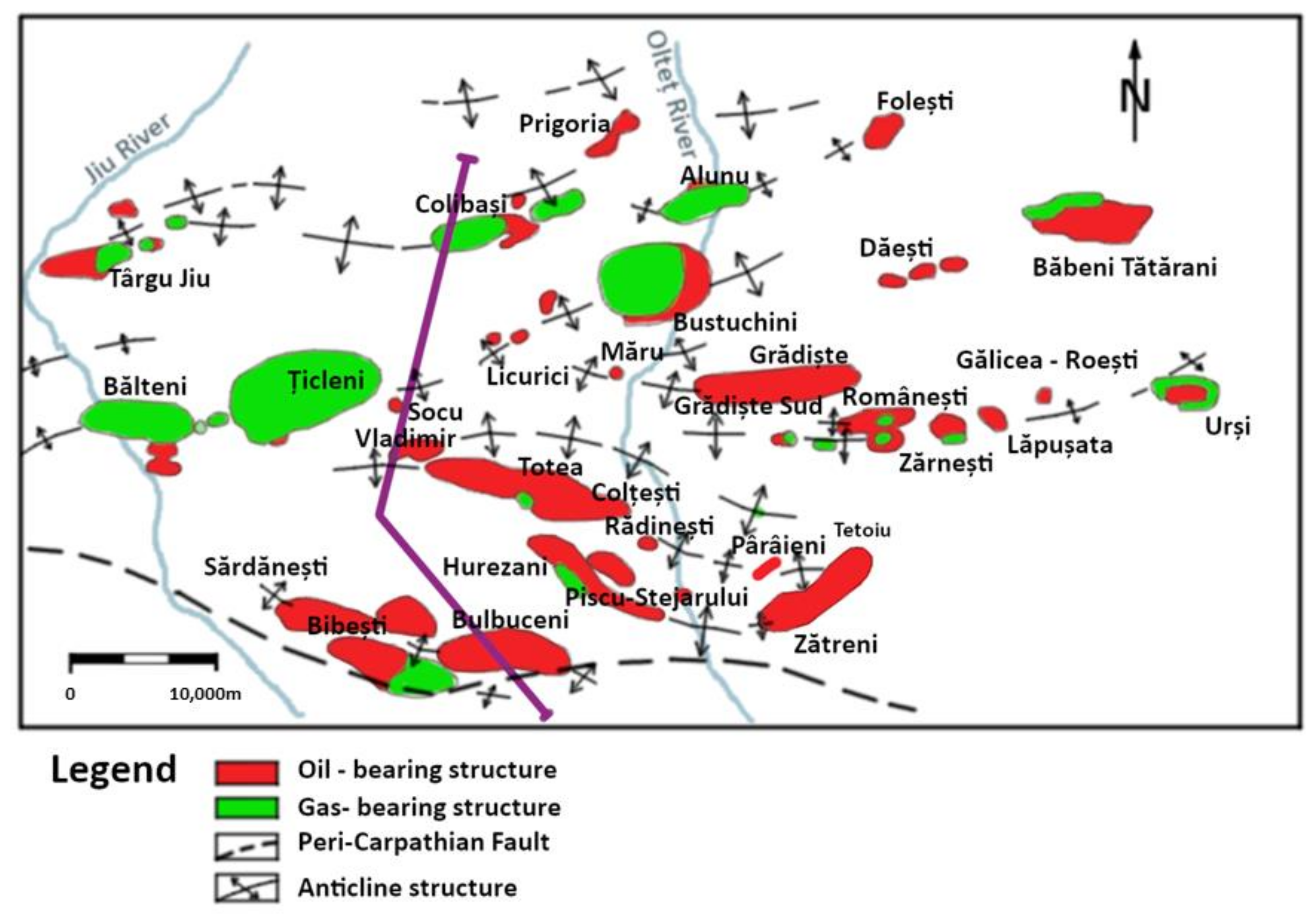
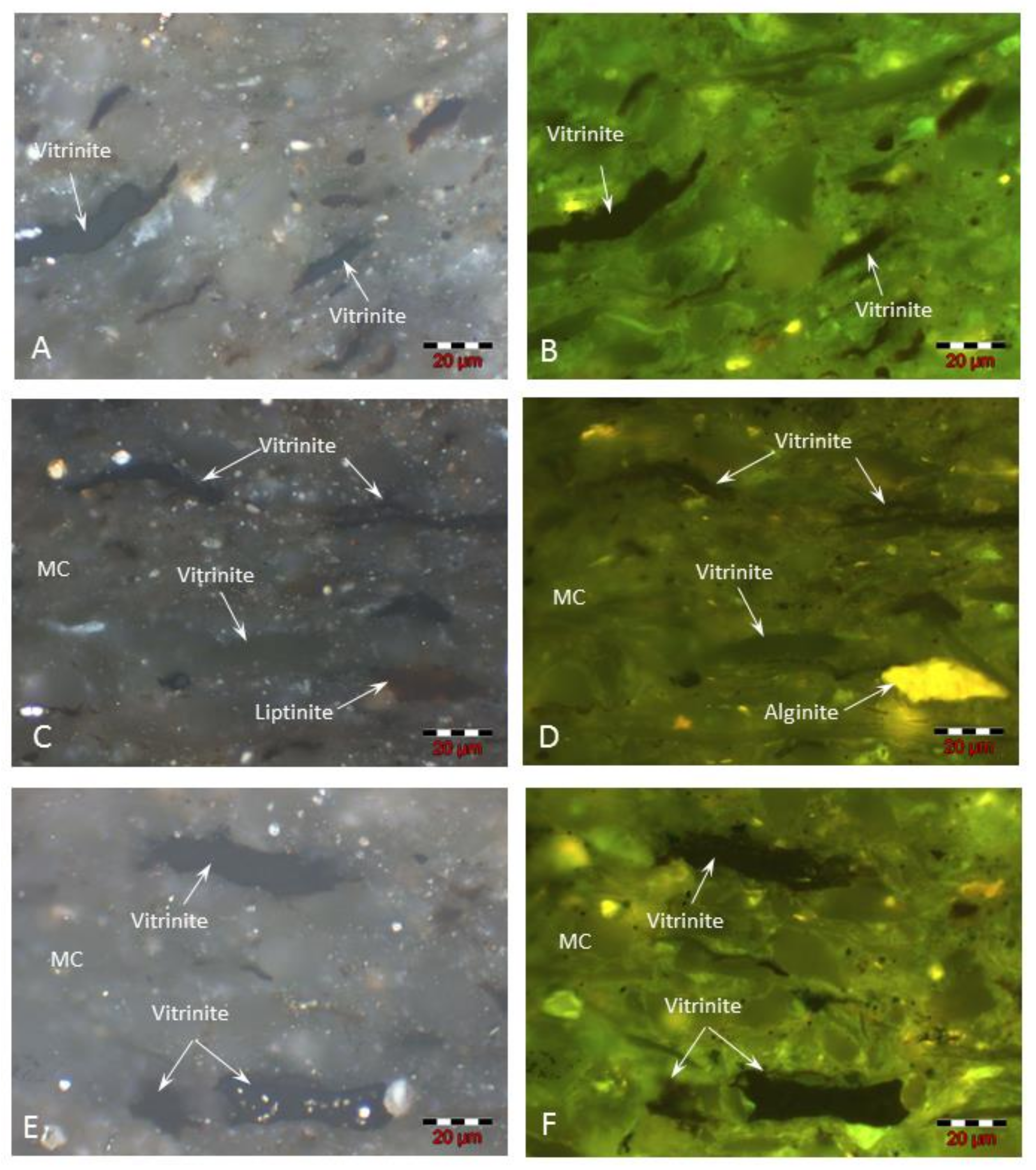
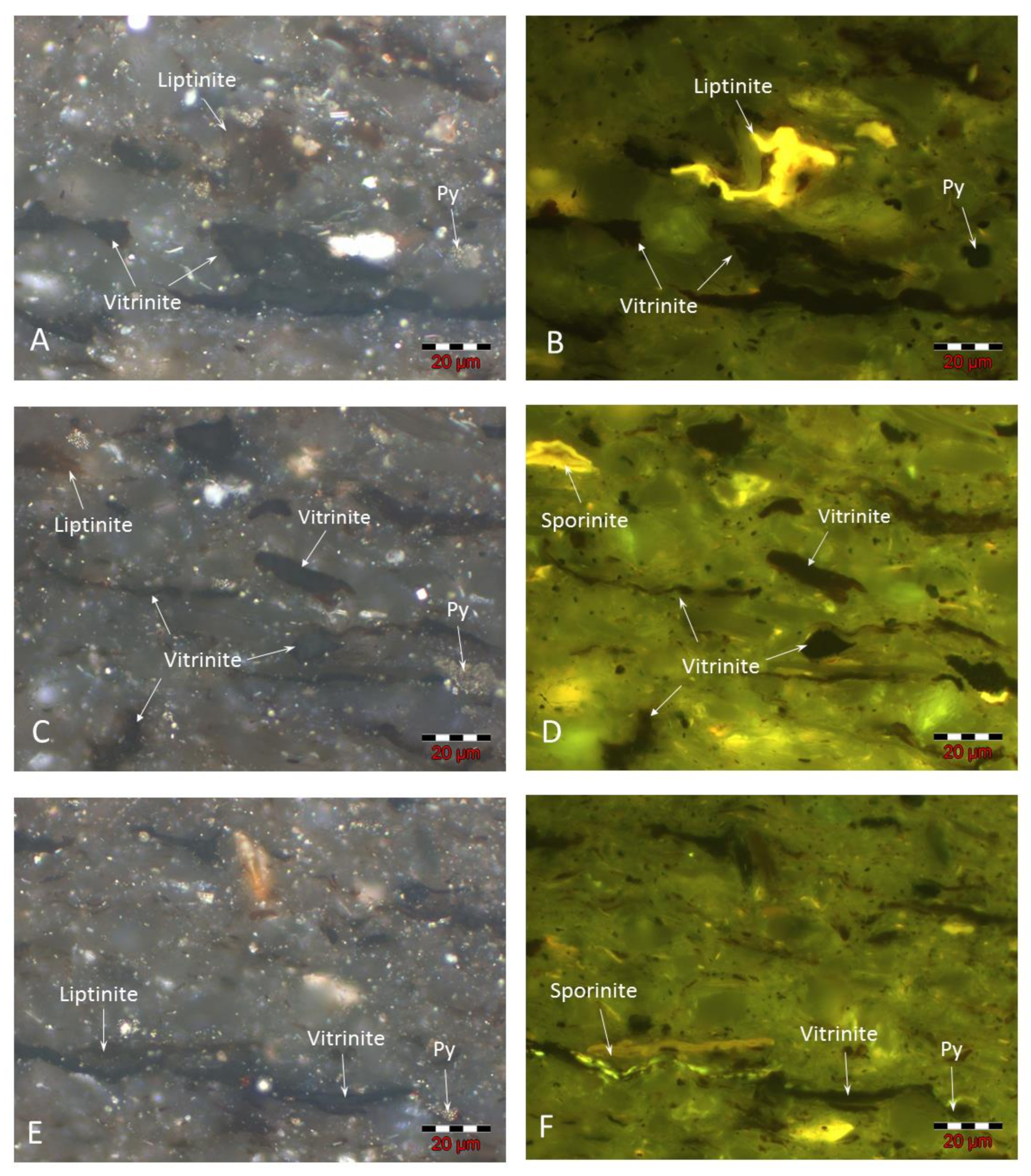
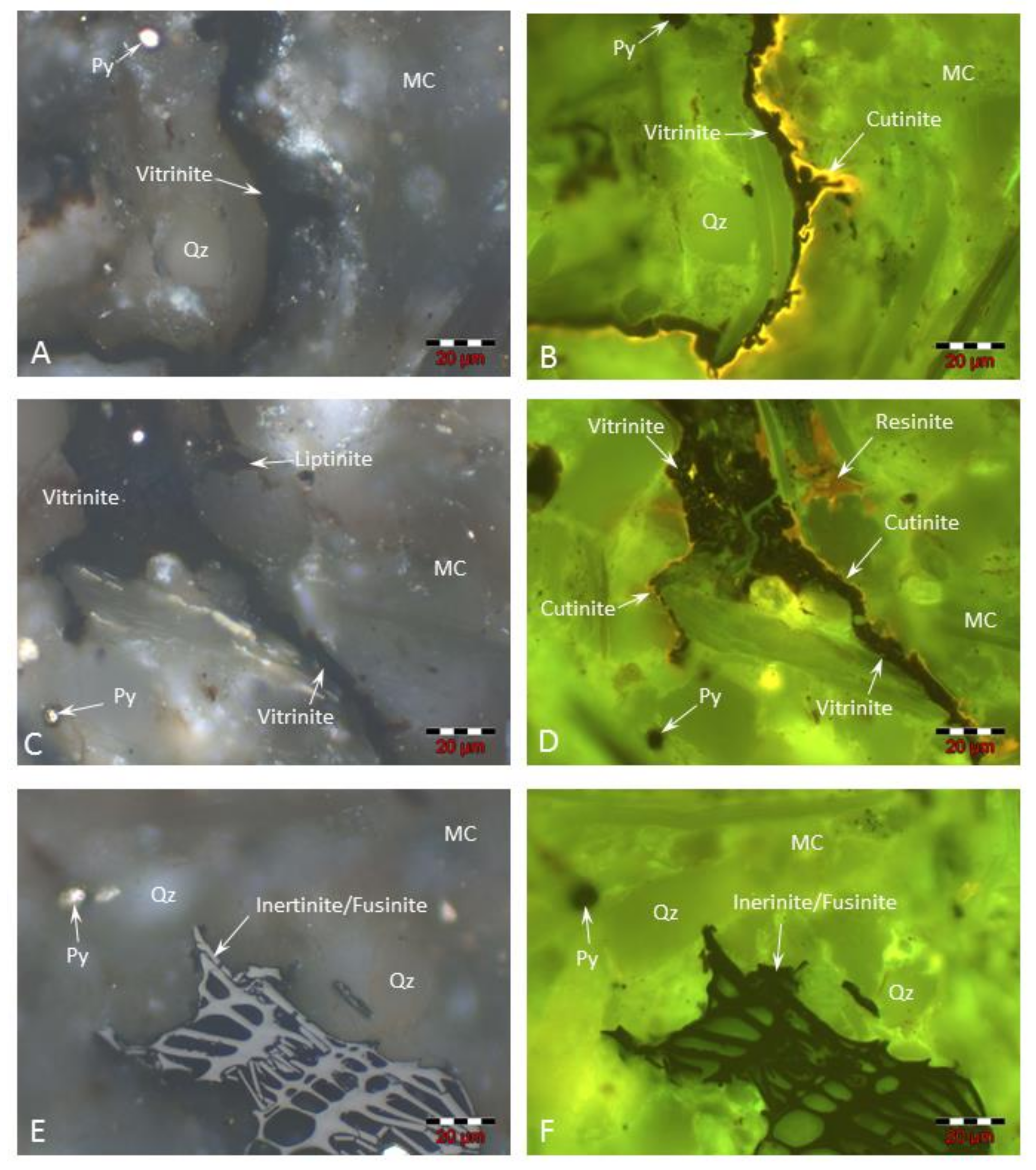
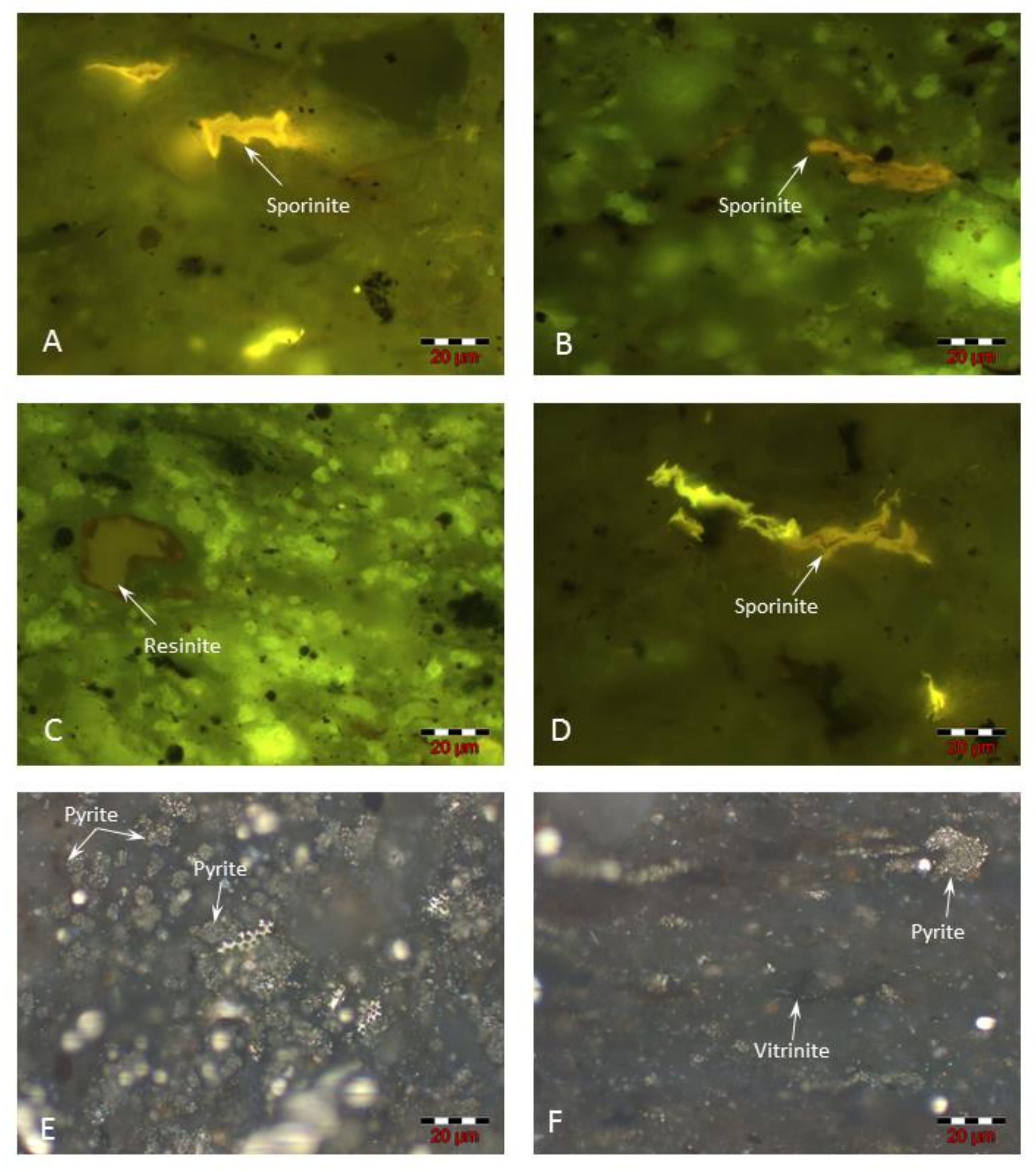
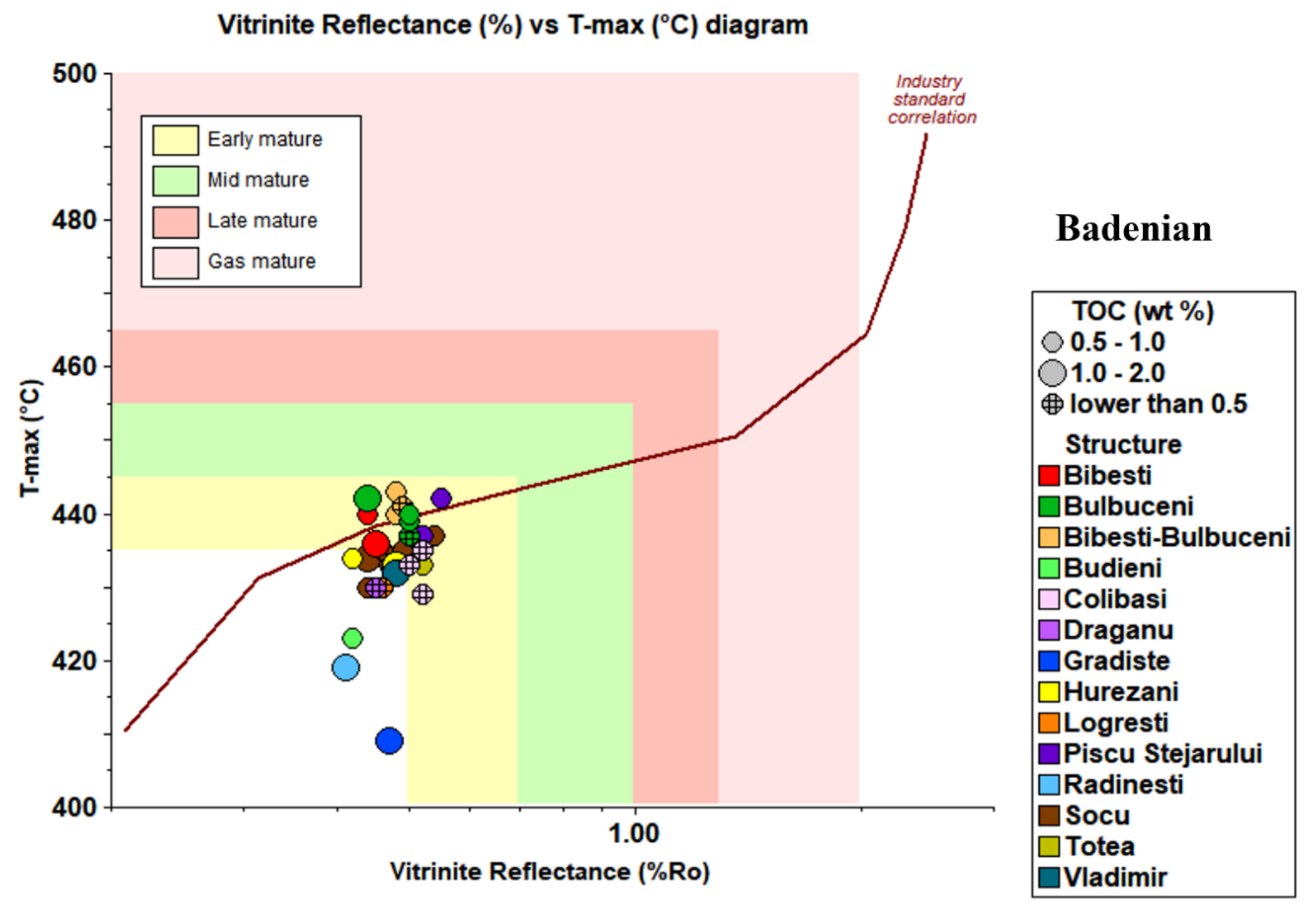
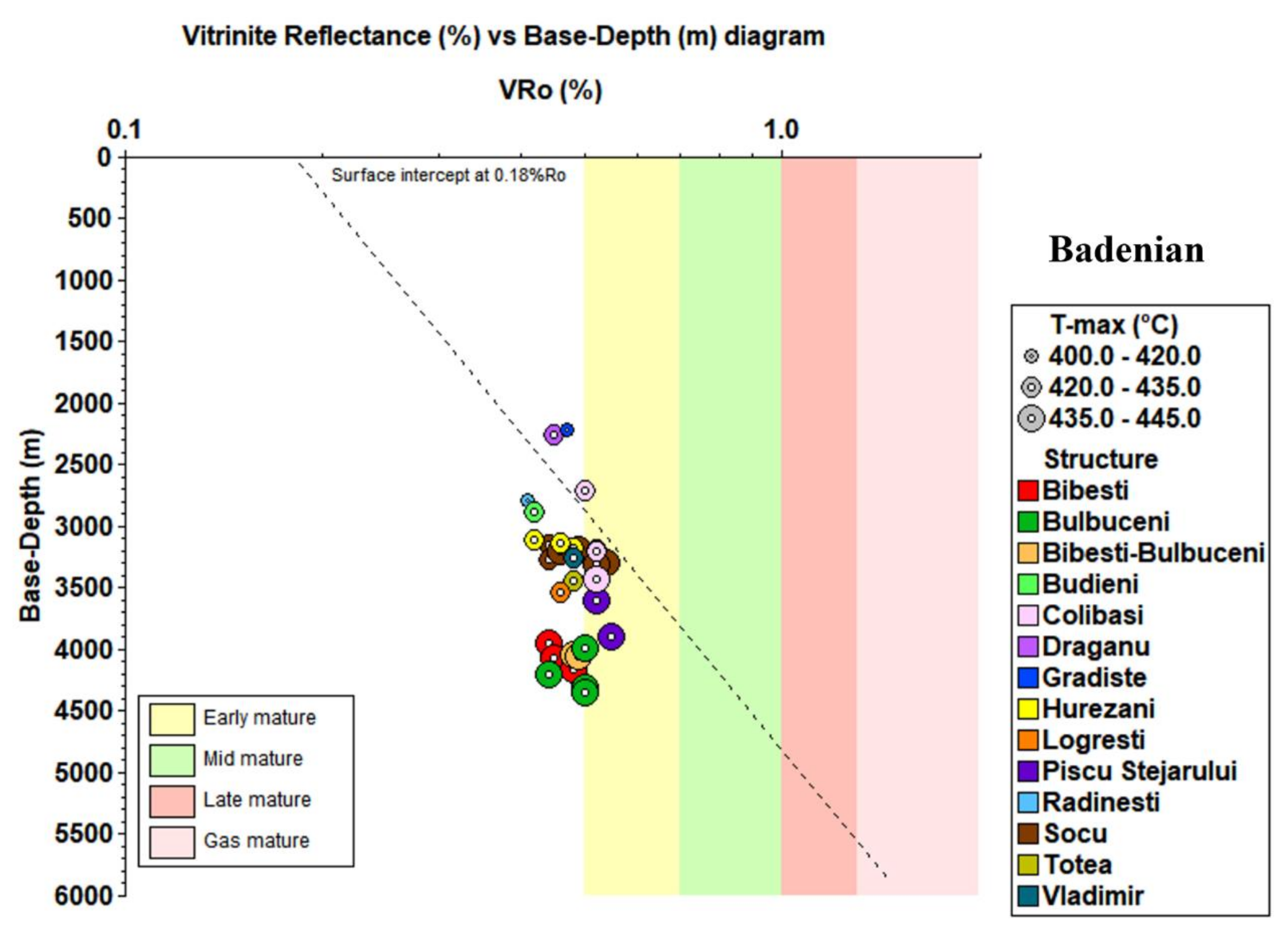
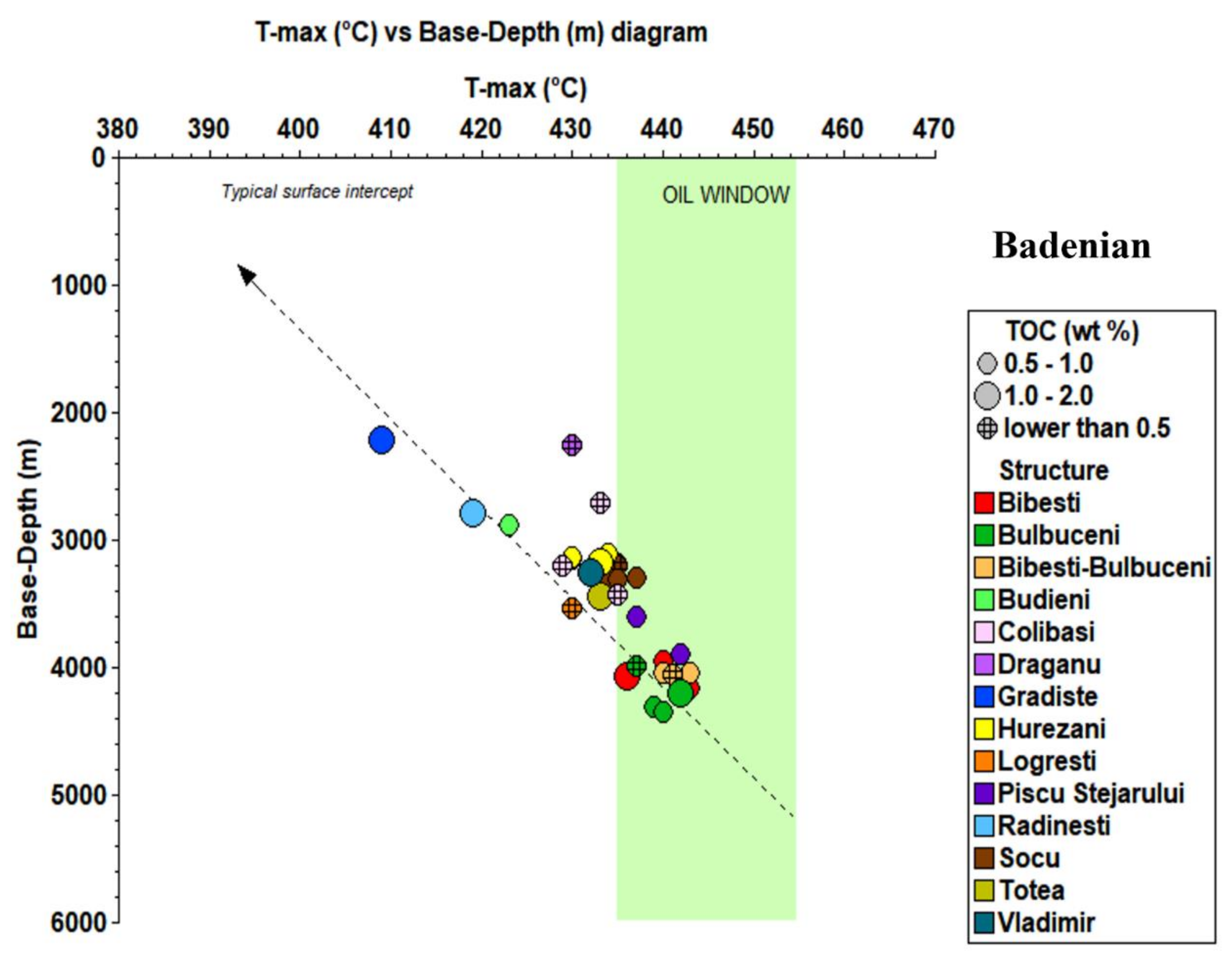

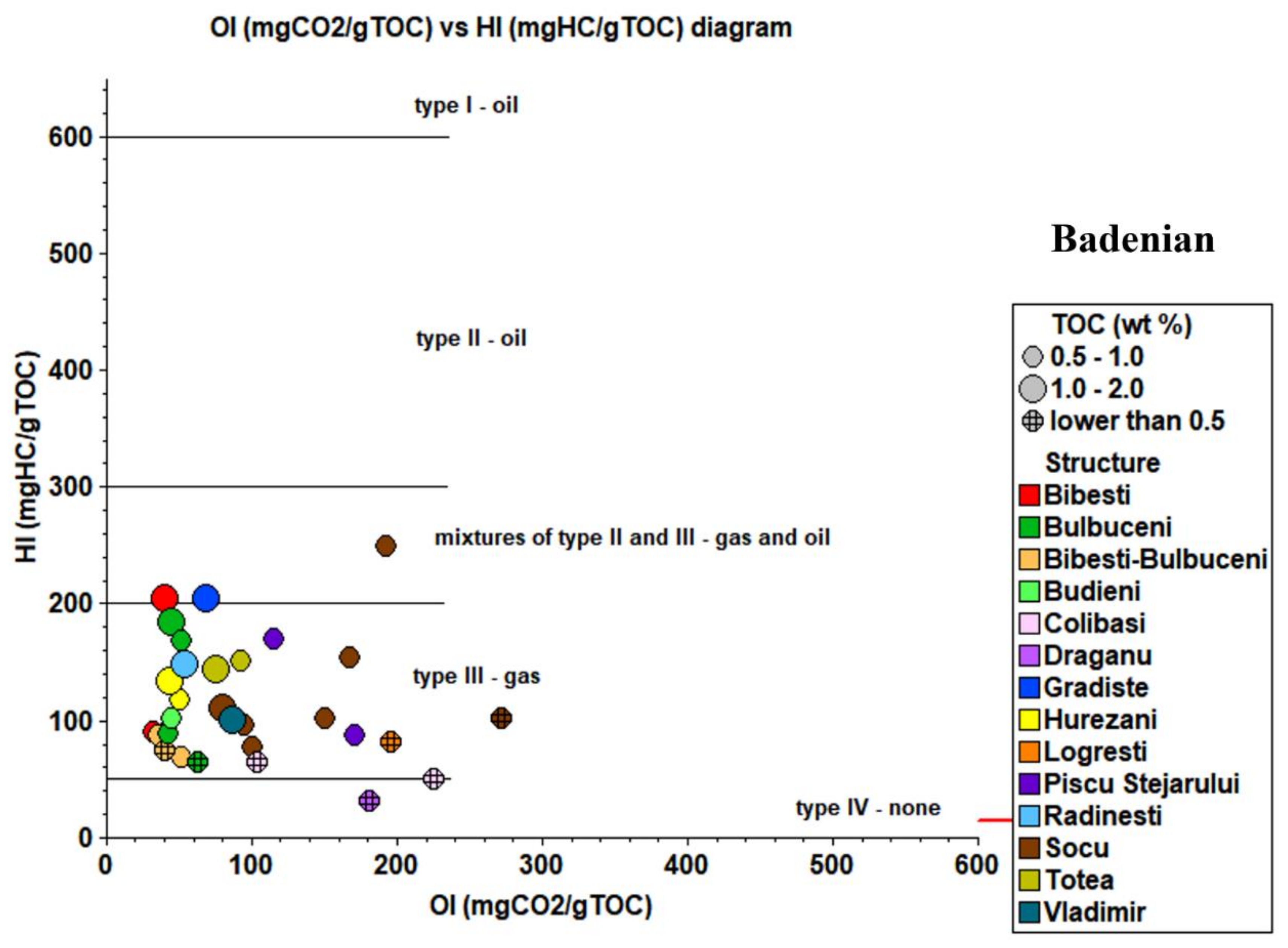
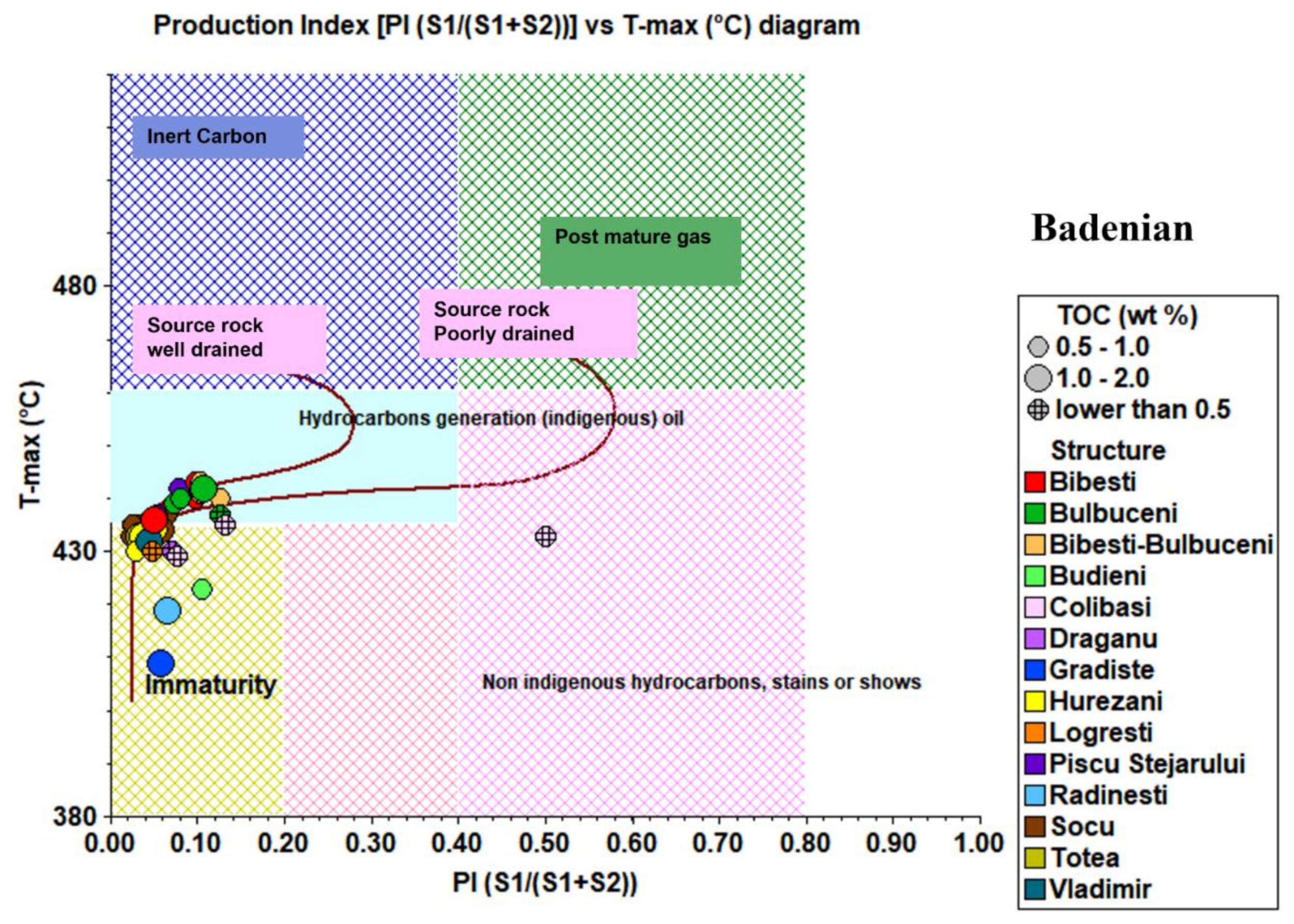
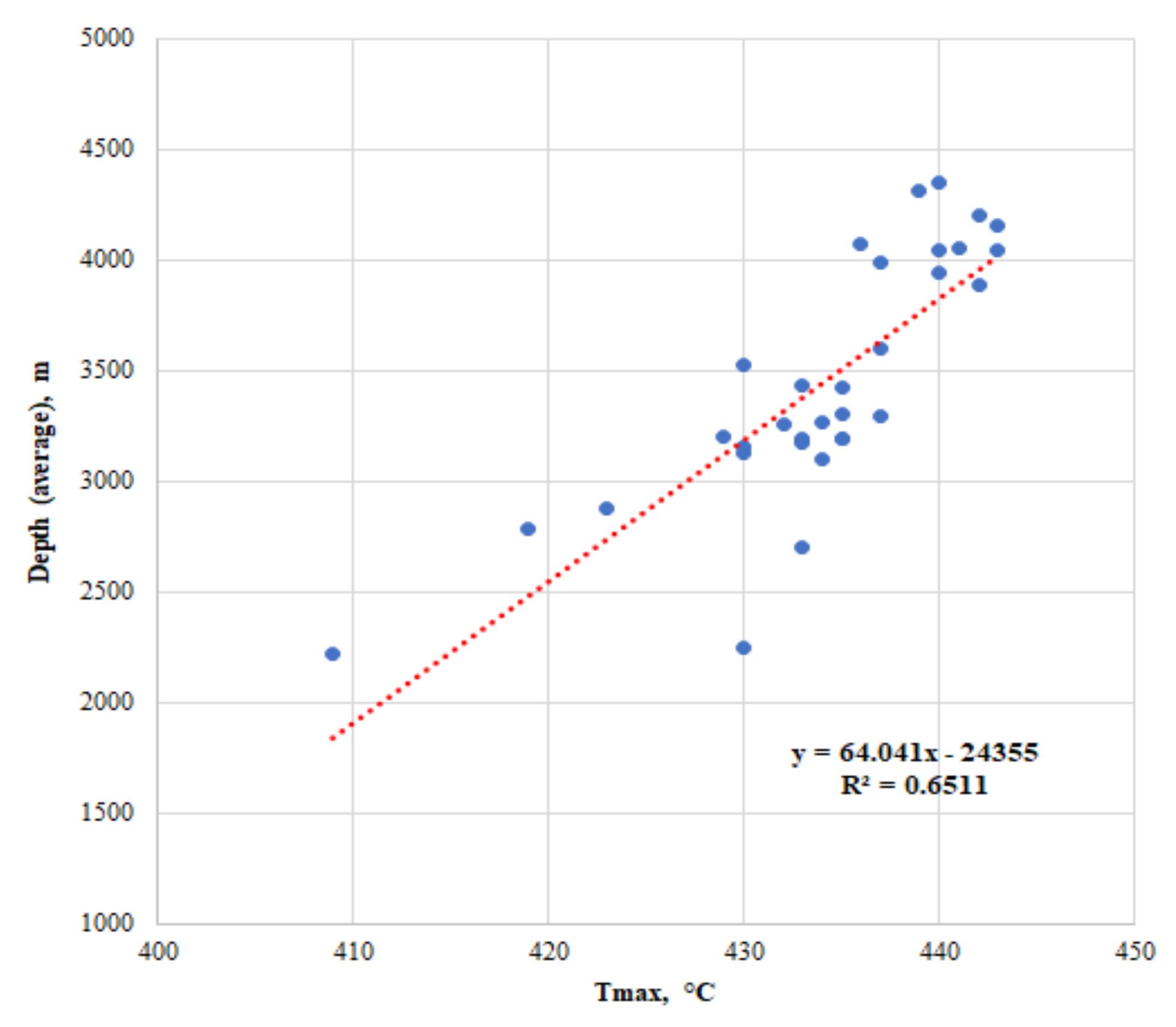

| No. | Well | Depth, m | TOC wt.% | S1, mg HC/g rock | S2, mg HC/g rock | S3, mg CO2/g rock | Tmax, °C | HI, mg HC/g TOC | OI, mg CO2/g TOC | PI (S1/ (S1+S2) | S2/S3 | VRo, % | Standard Dev. | Petrographic Composition | Kerogen Type | Generation Potential |
|---|---|---|---|---|---|---|---|---|---|---|---|---|---|---|---|---|
| 1 | A-1 Grădiște | 2200–2300 | 1.82 | 0.23 | 3.74 | 1.25 | 409 | 206 | 69 | 0.06 | 3.00 | 0.47 | 0.05 | V, Lag, Tag, R, In, Py, Sd, B | III | gas |
| 2 | A-1 Drăganu | 0.41 | 0.01 | 0.13 | 0.74 | 430 | 32 | 180 | 0.07 | 0.18 | 0.45 | 0.04 | V, I, Sd, B | IV | poor | |
| 3 | A-1 Colibași | 2600–2700 | 0.07 | 0.01 | 0.01 | 0.93 | 433 | 14 | 211 | 0.05 | 0.01 | 0.49 | 0.03 | V, Tag (Pr), Py | IV | poor |
| 4 | A-1 Rădinești | 2700–2800 | 1.35 | 0.14 | 2.01 | 0.73 | 419 | 150 | 55 | 0.07 | 2.75 | 0.41 | 0.07 | V, C, S, Tag (Pr, Ls), Py | III | gas |
| 5 | A-1 Budieni | 2800–2900 | 0.59 | 0.07 | 0.6 | 0.26 | 423 | 102 | 44 | 0.11 | 2.31 | 0.42 | 0.05 | V, Lag, Tag (Pr, Ls), I, Py | III | gas |
| 6 | A-1 Hurezani | 3000–3100 | 0.89 | 0.06 | 1.05 | 0.45 | 434 | 118 | 51 | 0.05 | 2.33 | 0.42 | 0.05 | V, C, R, S, Tag (Ts, Pr), F, Py, Sd | III | gas |
| 7 | B-1 Hurezani | 3100–3200 | 0.99 | 0.03 | 1.02 | 0.87 | 430 | 103 | 88 | 0.03 | 1.17 | 0.46 | 0.03 | V, S, C, Tag (Ts, Ls, Pr), Ld, I, Py, Sd | III | gas |
| 8 | B-1 Socu | 0.68 | 0.02 | 0.66 | 0.64 | 430 | 97 | 94 | 0.03 | 1.03 | 0.44 | 0.03 | V, Lag, Tag (Ts, Pr), R, S, Py, Sd | III | gas | |
| 9 | A-2 Hurezani | 1.20 | 0.06 | 1.61 | 0.52 | 433 | 134 | 43 | 0.04 | 3.10 | 0.48 | 0.04 | V, Ld, Py, Sd | III | gas | |
| 10 | A-1 Totea | 0.81 | 0.04 | 1.23 | 0.75 | 433 | 152 | 92 | 0.03 | 1.64 | 0.52 | 0.03 | V, S, Tag (Pr, Ls, Ts), I, Py | III | gas | |
| 11 | C-1 Socu | 0.54 | 0.02 | 0.55 | 0.81 | 435 | 103 | 150 | 0.03 | 0.68 | 0.49 | 0.04 | H/V, Tag (Ts, Pr, Ls), R, S, Py | IV | poor | |
| 12 | D-1 Socu | 0.5 | 0.03 | 1.25 | 0.96 | 433 | 272 | 195 | 0.03 | 1.30 | 0.47 | 0.04 | V, Tag (Ts, Ls, Pr), R, I, Sd, B | III | gas | |
| 13 | D-2 Socu | 0.39 | 0.01 | 0.4 | 1.06 | 435 | 103 | 278 | 0.02 | 0.38 | 0.46 | 0.04 | V, Tag (Ts, Ls, Pr), S, I, Py | IV | poor | |
| 14 | A-2 Colibași | 3200–3300 | 0.48 | 0.02 | 0.24 | 1.08 | 429 | 50 | 255 | 0.08 | 0.22 | 0.52 | 0.04 | V, Tag (Ls, Pr), Ld, S, Py | IV | poor |
| 15 | C-2 Socu | 1.04 | 0.07 | 1.15 | 0.83 | 434 | 111 | 80 | 0.05 | 1.39 | 0.44 | 0.06 | V, S, Tag (Ts, Pr), Py, Sd | III | gas | |
| 16 | A-1 Vladimir | 1.08 | 0.05 | 1.09 | 0.93 | 432 | 101 | 86 | 0.04 | 1.17 | 0.48 | 0.03 | V, Tag (Pr, Ls), S, R, Py | III | gas | |
| 17 | A-1 Socu | 0.55 | 0.03 | 0.43 | 0.55 | 437 | 78 | 100 | 0.07 | 0.78 | 0.54 | 0.04 | H/V, Tag (Ts, Pr, Ls), S, R, Ld, I, Py, Sd, B | IV | poor | |
| 18 | D-3 Socu | 0.52 | 0.02 | 0.8 | 0.87 | 435 | 154 | 168 | 0.02 | 0.34 | 0.52 | 0.05 | V, Tag (Ts, Ls, Pr), R, I, Py | IV | poor | |
| 19 | A-3 Colibași | 3400–3500 | 0.31 | 0.03 | 0.2 | 0.32 | 435 | 65 | 103 | 0.13 | 0.63 | 0.52 | 0.04 | V, Tag (Ls, Pr), Sd, B | IV | poor |
| 20 | B-1 Totea | 1.43 | 0.07 | 2.07 | 1.07 | 433 | 145 | 75 | 0.03 | 1.93 | 0.48 | 0.04 | V, Tag (Ts), Py | III | gas | |
| 21 | A-1 Logrești | 3500–3600 | 0.49 | 0.02 | 0.4 | 0.96 | 430 | 82 | 196 | 0.05 | 0.42 | 0.46 | 0.04 | V, Lag, Tag (Pr), S, Py, Sd | IV | poor |
| 22 | A-1 Piscu Stejarului | 3600–3700 | 0.61 | 0.03 | 0.54 | 1.04 | 437 | 88 | 171 | 0.05 | 0.52 | 0.52 | 0.05 | V, Tag (Ts, Pr), Lag, R, F, Py, Sd | IV | poor |
| 23 | A-2 Piscu Stejarului | 3800–3900 | 0.83 | 0.12 | 1.41 | 0.95 | 442 | 177 | 115 | 0.08 | 1.48 | 0.55 | 0.04 | V, Tag (Ts, Pr), Lag, Lp, S, R, I, Py, Sd | III | gas |
| 24 | A-1 Bibești | 3900–4000 | 0.51 | 0.05 | 0.46 | 0.21 | 440 | 90 | 41 | 0.1 | 2.19 | 0.44 | 0.04 | V, Tag(Ts, Ls, Pr), L(S, R), I, Py, Sd | III | gas |
| 25 | A-1 Bulbuceni | 0.43 | 0.04 | 0.28 | 0.27 | 437 | 65 | 63 | 0.13 | 1.04 | 0.5 | 0.04 | V, Lag, L(S), Tag (Pr, Ts, Ls), Py, Sd | III | gas | |
| 26 | A-1 Bib-Bulbuceni | 4000–4100 | 0.51 | 0.05 | 0.35 | 0.26 | 440 | 69 | 51 | 0.13 | 1.35 | 0.48 | 0.03 | V, Tag (Ls), L(S), Py | III | gas |
| 27 | A-2 Bib-Bulbuceni | 0.59 | 0.06 | 0.52 | 0.21 | 443 | 88 | 36 | 0.01 | 2.48 | 0.48 | 0.04 | V, Tag (Ls, Pr, Ts), Lp, S, R, I, Py | III | gas | |
| 28 | A-3 Bib-Bulbuceni | 0.47 | 0.04 | 0.35 | 0.19 | 441 | 74 | 40 | 0.01 | 1.84 | 0.49 | 0.04 | V, Tag (Ls, Ts), Lp, L(S, R), I, Py | III | gas | |
| 29 | A-2 Bibești | 1.04 | 0.11 | 2.13 | 0.41 | 436 | 205 | 39 | 0.05 | 5.19 | 0.45 | 0.03 | V, Tag (Ts, Pr, Ls), R, S, Py | III/II | gas and oil | |
| 30 | A-3 Bibești | 4100–4200 | 0.62 | 0.06 | 0.56 | 0.2 | 443 | 90 | 32 | 0.1 | 2.80 | 0.48 | 0.06 | V, Tag (Ts), Lag, Lp, R, S, I, Py, Sd | III | gas |
| 31 | B-1 Bulbuceni | 1.01 | 0.22 | 1.86 | 0.45 | 442 | 184 | 45 | 0.11 | 4.13 | 0.44 | 0.06 | V, Tag (Ts, Ls), Lag, Lp, L(S, C), Py, B | III | gas | |
| 32 | B-2 Bulbuceni | 4300–4400 | 0.57 | 0.04 | 0.51 | 0.24 | 439 | 89 | 42 | 0.07 | 2.13 | 0.5 | 0.08 | V, Tag (Pr), Lag, Ld, I, Py, Sd | III | gas |
| 33 | C-1 Bulbuceni | 0.55 | 0.08 | 0.93 | 0.28 | 440 | 169 | 51 | 0.08 | 3.32 | 0.51 | 0.05 | V, Tag (Ts), Ld, Py | III | gas |
| Statistical Parameter | TOC | S1 | S2 | S3 | Tmax | HI | OI | PI | VRo | S2/S3 | Depth |
|---|---|---|---|---|---|---|---|---|---|---|---|
| Mean | 0.723 | 0.058 | 0.925 | 0.645 | 434 | 113.939 | 101.181 | 0.080 | 0.478 | 1.673 | 3439.388 |
| Standard Deviation | 0.365 | 0.052 | 0.775 | 0.330 | 7.017 | 54.483 | 68.543 | 0.082 | 0.035 | 1.217 | 556.980 |
| Minimum | 0.070 | 0.010 | 0.010 | 0.190 | 409 | 14 | 32 | 0.020 | 0.410 | 0.010 | 2218 |
| Maximum | 1.820 | 0.230 | 3.740 | 1.250 | 443 | 272 | 278 | 0.500 | 0.550 | 5.190 | 4346.5 |
| Confidence Level for mean (95.0%) | ±0.129 | ±0.018 | ±0.275 | ±0.117 | ±2.488 | ±19.318 | ±24.304 | ±0.029 | ±0.012 | ±0.431 | ±197.496 |
| TOC | S1 | S2 | S3 | Tmax | HI | OI | PI | VRo | S2/S3 | Depth | |
|---|---|---|---|---|---|---|---|---|---|---|---|
| TOC | 1 | ||||||||||
| S1 | 0.717 | 1 | |||||||||
| S2 | 0.918 | 0.820 | 1 | ||||||||
| S3 | 0.301 | 0.013 | 0.327 | 1 | |||||||
| Tmax | −0.503 | −0.285 | −0.502 | −0.513 | 1 | ||||||
| HI | 0.554 | 0.581 | 0.760 | 0.206 | −0.163 | 1 | |||||
| OI | −0.430 | −0.474 | −0.335 | 0.690 | −0.150 | −0.182 | 1 | ||||
| PI | −0.411 | −0.065 | −0.305 | −0.134 | 0.091 | −0.437 | 0.095 | 1 | |||
| VRo | −0.304 | −0.257 | −0.234 | 0.121 | 0.362 | −0.102 | 0.244 | 0.076 | 1 | ||
| S2/S3 | 0.550 | 0.719 | 0.626 | −0.435 | 0.045 | 0.566 | −0.731 | −0.150 | −0.356 | 1 | |
| Depth | −0.228 | 0.047 | −0.205 | −0.610 | 0.807 | 0.057 | −0.418 | −0.045 | 0.259 | 0.381 | 1 |
Disclaimer/Publisher’s Note: The statements, opinions and data contained in all publications are solely those of the individual author(s) and contributor(s) and not of MDPI and/or the editor(s). MDPI and/or the editor(s) disclaim responsibility for any injury to people or property resulting from any ideas, methods, instructions or products referred to in the content. |
© 2023 by the authors. Licensee MDPI, Basel, Switzerland. This article is an open access article distributed under the terms and conditions of the Creative Commons Attribution (CC BY) license (https://creativecommons.org/licenses/by/4.0/).
Share and Cite
Ghiran, M.D.; Popa, M.E.; Mariș, I.; Predeanu, G.; Gheorghe, Ș.; Bălănescu, N.M. Thermal Maturity and Kerogen Type of Badenian Dispersed Organic Matter from the Getic Depression, Romania. Minerals 2023, 13, 202. https://doi.org/10.3390/min13020202
Ghiran MD, Popa ME, Mariș I, Predeanu G, Gheorghe Ș, Bălănescu NM. Thermal Maturity and Kerogen Type of Badenian Dispersed Organic Matter from the Getic Depression, Romania. Minerals. 2023; 13(2):202. https://doi.org/10.3390/min13020202
Chicago/Turabian StyleGhiran, Maria Doina, Mihai Emilian Popa, Izabela Mariș, Georgeta Predeanu, Ștefania Gheorghe, and Niculina Mihaela Bălănescu. 2023. "Thermal Maturity and Kerogen Type of Badenian Dispersed Organic Matter from the Getic Depression, Romania" Minerals 13, no. 2: 202. https://doi.org/10.3390/min13020202





